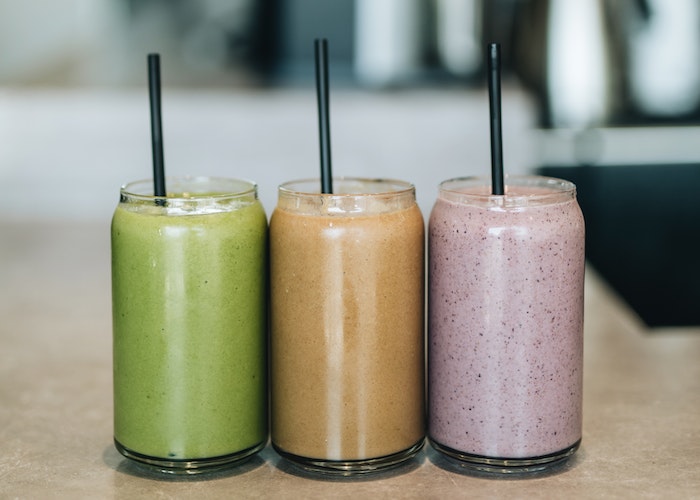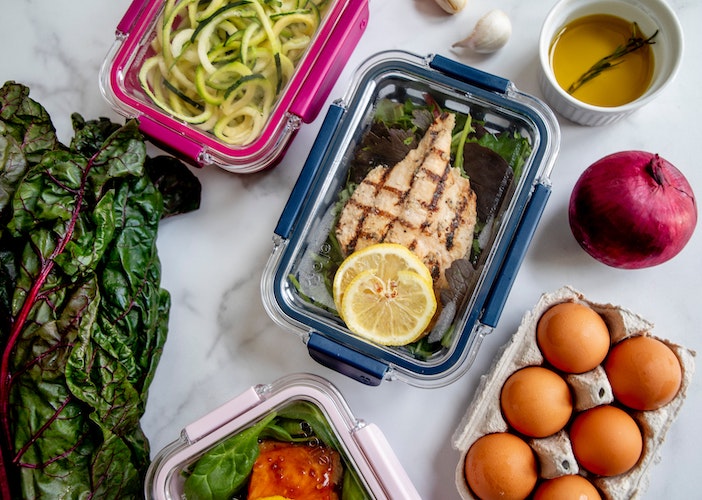The $3 Smoothie Recipe That Doesn’t Skimp On Taste

Confession: I used to think smoothies were overrated. I scoffed at this latest fitness trend, rolling my eyes at everyone splurging on protein powder, kale, organic fruits, and chia seeds. I was quite stubborn in my belief that oatmeal was the breakfast of winners; it’s budget-friendly, healthy, warm, filling, and an excuse to indulge in peanut butter every morning without guilt. But, with nothing but time on my hands during the global pandemic, I began to dig into the smoothie craze.
And, it turns out, there are a lot of nutritional benefits to consuming smoothies, that is, so long as you limit the amount of added sugar in your drink. If you’re vegetarian, in particular, a smoothie can help you hit fiber, protein, and vitamin goals quicker, and even if you’re not vegetarian, chances are that you aren’t eating as many fruits and vegetables as you should be.
But, there was still one area where I felt as if I was justified in sticking to my bowl of oatmeal: the cost. The retail price of a healthy, green smoothie can range close to $10, depending on your location. And while smoothies are easy to whip up at home, the number of recommended ingredients: almond butter, peanut butter, hemp hearts, chia seeds, flax seeds, pumpkin seeds, protein powder, spirulina powder, acai powder, etc, can be overwhelming. Like seriously, where does one begin? Well, recently I simplified the smoothie-making-process and hopefully found a cost-effective way for you to do it, too.
Editor’s Note: I’ve measured these ingredients for my own experiences, and they will typically be sufficient to make at least twenty smoothies, one for each weekday in a typical month.
First: spinach ($0.25 per serving)
You can easily find a 1lb bag of spinach for about $5 at your local grocery store, I guarantee it, and it’ll last you for roughly a months-worth of smoothies. You just have to freeze the box after a few days to make it last. I only ever make green smoothies since I firmly believe that if I’m going to go through the effort of blending one together, it better be healthy. Spinach doesn’t have a ton of flavor on its own, so I appreciate that it’s easy to combine with other ingredients while also providing plenty of fiber and nutrients. Assuming I can get twenty smoothies out of this bag, which I’ve been able to do in the past, this comes to $0.25/smoothie.
Next: fruits ($0.75 per serving)
Since I love a more tropical blend and taste to my shake, I’ll typically grab a mango, strawberry, and blueberry mix from the frozen aisle to mix-and-match my smoothie flavors with. I also recommend peaches and bananas, but truly, you can’t go wrong with any fruit you choose. You can typically find a 3lb bag of assorted fruits for anywhere from $6 to $9, depending on the store, and I’d say this would yield enough smoothies for two weeks, so about half the bag of spinach. In other words, assuming a modest $7.50/3lb bag and two of those per month, we’re looking at $0.75/smoothie.
Then: protein powder ($1 per serving)
Now, this is usually the most expensive ingredient to add to a smoothie, but I’d encourage readers to be strategic about their protein powder choices. I went with Orgain’s vanilla flavor since it’s made up of a simple blend of vegan ingredients, including chia seeds. I knew I wanted to incorporate chia seeds into my smoothies since they’re a source of both fiber and healthy fats, but the issue is that they’re simply too pricey. By picking a protein powder that already includes it in its blend, I knock out two birds with one stone. The Orgain nutritional label recommends two scoops of the protein powder per serving, but I honestly find the taste to be too overpowering. As such, I use just one scoop per smoothie and this lasts me for about 20 smoothies. Moreover, I’ve always been able to find Orgain on sale, either at Amazon, Costco, or Target, so though it’s priced higher, I’ve never paid more than $20 for a box. That’s just $1/smoothie, which isn’t the cheapest, but given that the protein powder will ensure I stay fuller longer, I say it’s worth it.
Finally: milk of your choice ($0.50 per serving)
I tend to buy almond or oat milk, since it lasts longer and grocery shopping for one person isn’t easy. I usually need a little over two 32-oz containers of milk to make twenty smoothies, so we’ll assume three to be on the safe side. This would cost about $10 for three containers, so about $0.50/smoothie.
Lastly (optional): any additional toppings
My simple recipes uses just oat milk, spinach, fruit, protein powder, and hemp hearts and I decided on the latter due to my personal brand of health issues. Hemp hearts are recommended for heart disease, which runs in my family, so I’m hoping that by incorporating this into my daily smoothies, I can get on top of an issue that has long plagued my family. I’d encourage everyone to do their own research on which add-ons may be necessary for them, and which can be optional or occasional splurges.
For instance, I love to occasionally add peanut butter or almond butter to a smoothie with just bananas.
I’ve found that a 1lb bag of hemp hearts is $10, twice the price of spinach! Luckily, I don’t use too much of it in each smoothie, so I make the bag last as long as my spinach, putting me at $0.50/smoothie for twenty smoothies.
While I haven’t extended my budget to include additions like spirulina powder or flax seeds or acai powder, chances are, you can find a protein powder that incorporates at least some of these ingredients. Personally, I find them to be too pricey.
The Grand Total: $3 Per Smoothie
If you’ve been keeping track, here’s the total: $3/smoothie. Now, these are relatively small smoothies, I won’t deny that, but I find that the inclusion of protein powder, healthy fats from hemp hearts, and fiber from berries and spinach, not to mention vitamins in vegan milk, keeps me quite full. I’ve definitely added nut butters, avocados, and even zucchini into these smoothies, which helps keep me fuller and would likely increase the cost of the smoothie to $3.50, if not $4 per smoothie, at times. But this is still vastly cheaper than buying a smoothie from a store.
The Takeaway:
The key to my minimalist smoothie routine is to find a protein powder that incorporates other additional ingredients you want to add, do the research to narrow down which of the “essential” smoothie additions are really necessary for you and your health, and finding a smoothie “structure” that works for you. Clearly I like green smoothies, but they aren’t for everyone. Others use chocolate or peanut butter protein powder for a sweeter, more dessert-like smoothie every time. I’ve seen riced cauliflower used instead of green vegetables. I’ve even seen bare-bones smoothie recipes that yield a smoothie bowl and then toppings used to make up for the remaining nutritional ingredients. Either way, there’s a smoothie recipe out there that works for everyone. You just need to spend a little time and effort to find it.
Keertana Anandraj is a recent college grad living in San Francisco. When she isn’t conducting international macroeconomic research at her day job, you can find her in the spin room or planning her next adventure.
Image via Unsplash
Like this story? Follow The Financial Diet on Facebook, Instagram, and Twitter for daily tips and inspiration, and sign up for our email newsletter here.



